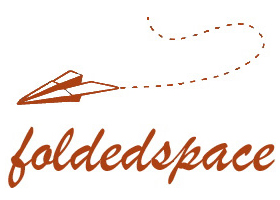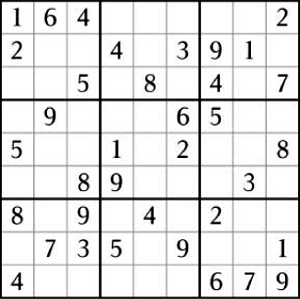A couple of weeks ago, the Sunday New York Times featured a new puzzle called sudoku, which is apparently popular in Japan. It’s a sort of self-checking number-based crossword without clues. Confused? Don’t be. There’s only one rule.
Given a 9×9 grid, fill in all blank cells making sure that each row, column, and 3×3 box contains each number from one to nine.
The above puzzle is very, very easy. Believe me: they can be much more difficult. Brain-wrackingly difficult. Sudoku are rated in difficulty based on the numbers provided, the ease with which other numbers can be found, and the number of guesses required to solve the puzzle.
The real problem is sudoku is addicting. Last night in the grocery store, I saw a sudoku magazine. I tried to resist the urge to purchase it, but failed. I spent most of my evening doing sudoku. I solved easy puzzles, then medium puzzles, then hard puzzles.
I’ve spent too much time this morning trying to solve two difficult puzzles. I’ve exhausted elementary logic tricks and need to find some more elaborate methods of finding the correct numbers. I’ve gone to the web in search of help, and found:
- the wikipedia article on sudoku
- a sudoku program for Windows — this site includes a page discussing techniques for solving sudoku
- a sudoku site with some basic strategy tips and a few free online puzzles
- a sudoku weblog (!!?!!) which includes daily puzzles
- best of all: two sudoku apps for Macintosh: Sudoku Susser and MacSudoku
Now, if you’ll excuse me, I need to go back to the two sudoku that I’m stuck on. Must finish. Must.


A Sudoku weblog is a great idea! I started a daily email subscription or RSS feed of sudoku puzzles. Please try it out and let me know what you think. Thanks.
I found a pretty cool Sudoku site. It’s called SudokuCentral.net. Some of the puzzles are pretty tough. Here’s the link for it.
SudokuCentral.net
“Computer Aided Sudoku” free excel game to download at http://perso.wanadoo.fr/sudoku.laviron will help you and give the solution (only if you need it)
I am addicted to Sudoku! I made an inventory of methods for solving even the most difficult Sudoku. Start with looking for duo’s, it’s an eye opener!
Check http://www.sudokuhints.nl/en/ for details.
Good luck!
SUDOKU EXCEL free download
“Computer Aided Sudoku Excel” includes now new features :
– generator of sudoku puzzles to print or to play
– helper solver
– SURPRISES when you solve the sudoku without help
– HISTORIC records all the plays. Partial replay.
– Sudoku CLINIC for analysing sudoku
Enjoy playing this free Sudoku Excel game on your computer.
http://perso.wanadoo.fr/sudoku.laviron
Online sudoku for kids with images of Garfield, Harry Potter, …
http://www.sudokupuzzle.toplink.be
My math teacher gace me a sheet that she copied out of one of her books, and told me how to do them. I started working on it im my next class. I was so much fum! The next day, I went up to her and got another ome! It was so much fun! The thing is that they are very addicting! 🙂
Are you gay??? this sudoku is all to easy:O
I love sudoku. It is awsome. Once I did a level 100 in 2 minutes. They r awsome:)